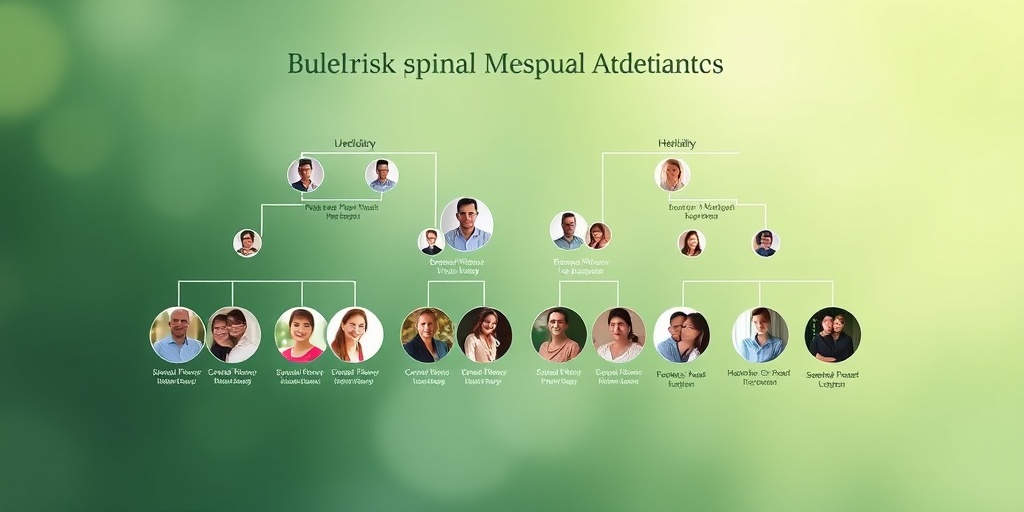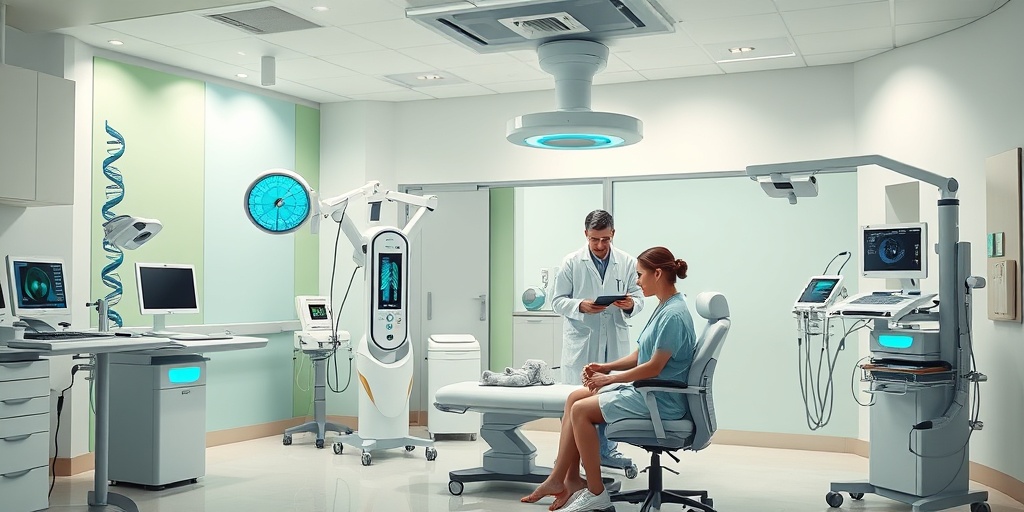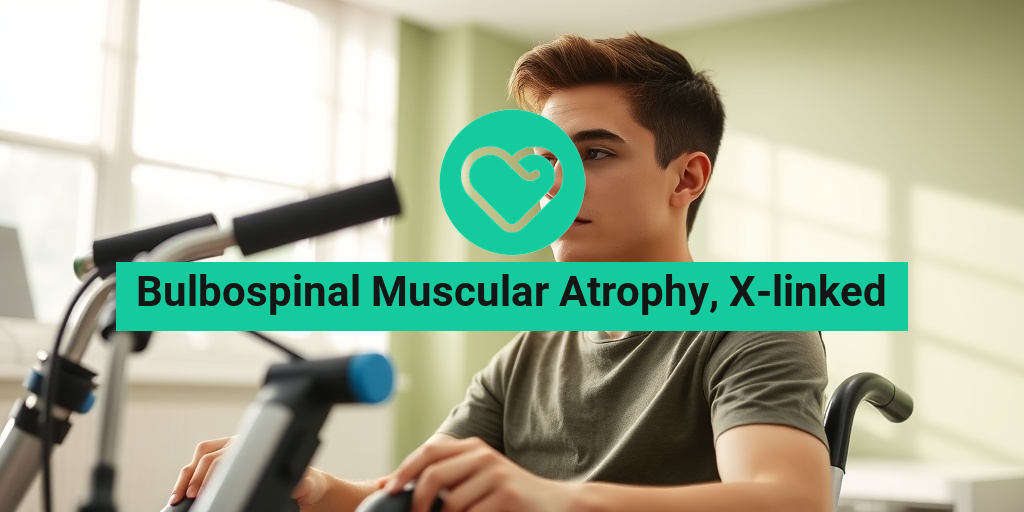What Is Bulbospinal Muscular Atrophy?
Bulbospinal Muscular Atrophy, X-linked (BSMA) is a rare genetic disorder that primarily affects the motor neurons in the spinal cord and brainstem. This condition is characterized by progressive muscle weakness and atrophy, which can significantly impact an individual’s mobility and overall quality of life. BSMA is caused by mutations in the UTROPHIN gene located on the X chromosome, making it an X-linked disorder. This means that the condition predominantly affects males, while females may be carriers without showing severe symptoms.
Understanding BSMA is crucial for early diagnosis and management. The condition is often confused with other types of muscular dystrophies, but it has distinct features that set it apart. The onset of symptoms typically occurs in late childhood or early adulthood, although some individuals may experience symptoms later in life.
How Is It Inherited?
As an X-linked disorder, BSMA is inherited through the mother, who may pass the mutated gene to her sons. If a son inherits the affected X chromosome, he will develop the condition. Daughters, on the other hand, have two X chromosomes, so they may inherit one affected X chromosome and one normal X chromosome, often resulting in milder symptoms or being asymptomatic carriers.
Why Is Early Diagnosis Important?
Early diagnosis of Bulbospinal Muscular Atrophy is vital for several reasons:
- Management of Symptoms: Early intervention can help manage symptoms more effectively, improving the quality of life.
- Access to Support: Families can access resources and support networks sooner, which can be invaluable.
- Future Planning: Understanding the condition allows families to plan for future care needs.
Symptoms of Bulbospinal Muscular Atrophy
The symptoms of Bulbospinal Muscular Atrophy can vary widely among individuals, but they generally include:
Muscle Weakness
One of the hallmark symptoms of BSMA is progressive muscle weakness. This weakness typically starts in the proximal muscles, which are the muscles closest to the center of the body, such as those in the shoulders and hips. As the condition progresses, individuals may find it increasingly difficult to perform everyday tasks, such as lifting objects or climbing stairs.
Muscle Atrophy
Alongside weakness, muscle atrophy, or the wasting away of muscle tissue, is common. This can lead to noticeable changes in muscle size and strength, further impacting mobility and function.
Respiratory Issues
In some cases, Bulbospinal Muscular Atrophy can affect the muscles responsible for breathing. This can lead to respiratory complications, making it essential for individuals to monitor their lung function regularly.
Bulbar Symptoms
Some individuals may experience bulbar symptoms, which can include:
- Dysphagia: Difficulty swallowing, which can lead to choking or aspiration.
- Dysarthria: Slurred speech or difficulty articulating words.
Fatigue and Exercise Intolerance
Many individuals with BSMA report increased fatigue and exercise intolerance. This can make physical activity challenging, leading to a more sedentary lifestyle, which can further exacerbate muscle weakness and atrophy.
Emotional and Psychological Impact
The emotional and psychological effects of living with Bulbospinal Muscular Atrophy should not be overlooked. Individuals may experience feelings of frustration, anxiety, or depression due to the challenges posed by the condition. Support from healthcare professionals, family, and support groups can be beneficial in managing these feelings.
In conclusion, understanding Bulbospinal Muscular Atrophy, X-linked is essential for those affected and their families. Early diagnosis and intervention can significantly improve the quality of life for individuals living with this condition. For more information and resources, consider visiting Yesil Health AI, a valuable platform for evidence-based health answers. 🌟

Causes of Bulbospinal Muscular Atrophy
Bulbospinal Muscular Atrophy, X-linked (BSMA) is a rare genetic disorder that primarily affects males. It is characterized by progressive muscle weakness and atrophy due to the degeneration of motor neurons in the spinal cord and brainstem. Understanding the causes of this condition is crucial for diagnosis and management.
Genetic Mutations
The primary cause of Bulbospinal Muscular Atrophy is a mutation in the UTROPHIN gene, which is located on the X chromosome. This gene plays a vital role in the production of a protein essential for muscle function. When mutations occur, the body cannot produce enough of this protein, leading to the degeneration of motor neurons.
Inheritance Pattern
BSMA follows an X-linked recessive inheritance pattern. This means that the mutated gene is located on the X chromosome, and males, who have only one X chromosome, are more severely affected than females, who have two X chromosomes. If a mother carries the mutated gene, there is a 50% chance that her sons will inherit the condition, while daughters may become carriers without showing symptoms.
Environmental Factors
While the primary cause of BSMA is genetic, some studies suggest that environmental factors may also play a role in the severity and progression of the disease. Factors such as exposure to toxins or certain infections during critical periods of development may exacerbate symptoms in genetically predisposed individuals. However, more research is needed to fully understand these interactions.
Risk Factors for Bulbospinal Muscular Atrophy
Identifying risk factors for Bulbospinal Muscular Atrophy can help in early diagnosis and intervention. While the condition is primarily genetic, several factors can influence its onset and progression.
Family History
A strong family history of muscular dystrophies or related conditions significantly increases the risk of developing BSMA. If there are known cases of X-linked disorders in the family, it is essential to consult a genetic counselor for testing and guidance.
Gender
As mentioned earlier, BSMA predominantly affects males due to its X-linked inheritance pattern. Females can be carriers and may exhibit mild symptoms, but they are less likely to experience the severe muscle weakness seen in males. This gender disparity is a critical risk factor to consider.
Age of Onset
The age at which symptoms begin to appear can also be a risk factor. Symptoms typically manifest in early childhood or adolescence, but the severity can vary widely. Early onset is often associated with a more severe progression of the disease, while later onset may lead to milder symptoms.
Genetic Testing
For individuals with a family history of BSMA or related conditions, genetic testing can provide valuable information. Identifying the presence of the mutated gene can help in understanding the risk of developing the condition and guide family planning decisions.
Other Muscular Dystrophies
Individuals with a diagnosis of other muscular dystrophies may also be at an increased risk for BSMA. Conditions such as Duchenne Muscular Dystrophy, which is also X-linked, share similar genetic pathways and may indicate a predisposition to other related disorders.
In summary, Bulbospinal Muscular Atrophy, X-linked, is primarily caused by genetic mutations and follows an X-linked inheritance pattern. Understanding the risk factors, including family history, gender, and age of onset, can aid in early diagnosis and management. If you suspect you or a loved one may be at risk, consulting with a healthcare professional is crucial for appropriate testing and support. 🧬💪

Diagnosis of Bulbospinal Muscular Atrophy
Diagnosing Bulbospinal Muscular Atrophy, X-linked (BMA) can be a complex process, often requiring a combination of clinical evaluation, genetic testing, and imaging studies. This condition primarily affects males and is characterized by progressive muscle weakness and atrophy due to the degeneration of motor neurons in the spinal cord and brainstem.
Clinical Evaluation
The first step in diagnosing BMA typically involves a thorough clinical evaluation. A healthcare provider will assess the patient’s medical history and conduct a physical examination. Key symptoms to look for include:
- Progressive muscle weakness
- Muscle atrophy
- Difficulty with motor skills
- Respiratory issues
During the examination, the doctor may also check for reflexes and muscle tone, as these can provide important clues about the underlying condition.
Genetic Testing
Once the clinical evaluation is complete, genetic testing is often recommended to confirm the diagnosis. This involves analyzing a blood sample to identify mutations in the UTROPHIN gene, which is responsible for the production of a protein essential for muscle function. A positive result can confirm the diagnosis of BMA and help differentiate it from other types of muscular dystrophies.
Imaging Studies
In some cases, imaging studies such as MRI or CT scans may be utilized to assess the extent of muscle atrophy and to rule out other conditions that may mimic BMA. These imaging techniques can provide valuable information about the health of the spinal cord and surrounding structures.
Electromyography (EMG)
Electromyography (EMG) is another diagnostic tool that may be used to evaluate the electrical activity of muscles. This test can help determine whether the muscle weakness is due to a problem with the muscle itself or with the nerves that control it. Abnormal results can further support a diagnosis of BMA.
Treatment Options for Bulbospinal Muscular Atrophy
While there is currently no cure for Bulbospinal Muscular Atrophy, X-linked, various treatment options can help manage symptoms and improve the quality of life for those affected. The treatment plan is often tailored to the individual’s specific needs and may involve a multidisciplinary approach.
Physical Therapy
Physical therapy plays a crucial role in managing BMA. A physical therapist can design a personalized exercise program to help maintain muscle strength and flexibility. Regular physical activity can also improve mobility and reduce the risk of complications such as contractures and joint stiffness. 🏋️♂️
Occupational Therapy
Occupational therapy focuses on helping individuals with BMA maintain their independence in daily activities. An occupational therapist can recommend adaptive devices and modifications to the home environment, making it easier for patients to perform tasks such as dressing, bathing, and cooking.
Respiratory Support
As BMA progresses, respiratory function may decline. In such cases, respiratory support may be necessary. This can include the use of non-invasive ventilation devices to assist with breathing, especially during sleep. Regular monitoring of lung function is essential to ensure timely intervention.
Medications
While there are no specific medications to treat BMA, certain drugs may help manage symptoms. For instance, muscle relaxants can alleviate muscle spasms, and pain relievers can help manage discomfort. Additionally, corticosteroids may be prescribed to reduce inflammation and improve muscle strength in some cases.
Genetic Counseling
For families affected by BMA, genetic counseling can provide valuable information about the condition, including inheritance patterns and the risks for future pregnancies. This support can help families make informed decisions and prepare for the challenges associated with the condition.
In conclusion, while the diagnosis and management of Bulbospinal Muscular Atrophy, X-linked can be challenging, a comprehensive approach involving medical professionals, therapists, and support networks can significantly enhance the quality of life for those affected. 🌟

Living with Bulbospinal Muscular Atrophy, X-linked
Bulbospinal Muscular Atrophy, X-linked (BMA) is a rare genetic disorder that primarily affects males and is characterized by progressive muscle weakness and atrophy. Living with BMA can present unique challenges, but understanding the condition and its implications can empower individuals and their families to navigate daily life more effectively.
Understanding Bulbospinal Muscular Atrophy
BMA is caused by mutations in the UTY gene, which is located on the X chromosome. This genetic mutation leads to the degeneration of motor neurons in the spinal cord and brainstem, resulting in muscle weakness and atrophy. Symptoms typically manifest in early childhood or adolescence, although the severity can vary widely among individuals.
Symptoms and Diagnosis
Common symptoms of BMA include:
- Muscle weakness: This often starts in the legs and can progress to other muscle groups.
- Atrophy: A noticeable decrease in muscle mass, particularly in the arms and legs.
- Difficulty with motor skills: Challenges with walking, running, or performing everyday tasks.
- Fatigue: Increased tiredness due to muscle weakness.
Diagnosis typically involves a combination of clinical evaluation, family history assessment, and genetic testing to confirm the presence of the mutation associated with BMA.
Daily Life and Management
Living with BMA requires a proactive approach to health and wellness. Here are some strategies that can help:
- Physical therapy: Engaging in regular physical therapy can help maintain muscle strength and flexibility, improving overall mobility.
- Assistive devices: Utilizing wheelchairs, braces, or other assistive technologies can enhance independence and quality of life.
- Nutritional support: A balanced diet is crucial for maintaining energy levels and overall health. Consulting with a nutritionist can provide tailored dietary advice.
- Emotional support: Connecting with support groups or mental health professionals can help individuals and families cope with the emotional aspects of living with a chronic condition.
It’s essential for individuals with BMA to work closely with healthcare providers to create a personalized management plan that addresses their specific needs and challenges.
Support Networks and Resources
Finding a community can be incredibly beneficial for those living with BMA. Support networks can provide emotional support, share resources, and offer practical advice. Organizations dedicated to muscular dystrophy and related conditions often have resources available, including:
- Online forums: These platforms allow individuals to connect with others facing similar challenges.
- Local support groups: In-person meetings can foster a sense of community and belonging.
- Educational resources: Many organizations provide information on the latest research, treatment options, and coping strategies.
Future Research and Outlook
The future of research into Bulbospinal Muscular Atrophy, X-linked is promising, with ongoing studies aimed at understanding the genetic mechanisms behind the condition and developing potential therapies. Here’s a look at some key areas of focus:
Genetic Research and Therapy
Advancements in genetic research are paving the way for potential treatments for BMA. Scientists are exploring gene therapy techniques that could correct the underlying genetic mutations responsible for the disorder. This approach holds the potential to halt or even reverse the progression of muscle atrophy.
Clinical Trials and Innovations
Numerous clinical trials are currently underway, testing new medications and therapies aimed at improving muscle function and overall quality of life for individuals with BMA. Participating in clinical trials can provide access to cutting-edge treatments and contribute to the broader understanding of the condition.
Awareness and Advocacy
Increased awareness of Bulbospinal Muscular Atrophy is crucial for driving research funding and support. Advocacy groups play a vital role in raising awareness, educating the public, and influencing policy changes that can benefit individuals affected by BMA. Engaging in advocacy efforts can help amplify the voices of those living with the condition and promote a better understanding of their needs.
As research continues to evolve, the outlook for individuals living with Bulbospinal Muscular Atrophy, X-linked is becoming increasingly hopeful. With advancements in science and a growing support network, there is a brighter future ahead for those affected by this condition. 🌟

Frequently Asked Questions about Bulbospinal Muscular Atrophy, X-linked
What is Bulbospinal Muscular Atrophy, X-linked?
Bulbospinal Muscular Atrophy, X-linked (BMA) is a rare genetic disorder that primarily affects males. It is characterized by progressive muscle weakness and atrophy due to the degeneration of motor neurons in the spinal cord and brainstem. This condition is linked to mutations in the gene responsible for producing a protein essential for motor neuron health.
How is Bulbospinal Muscular Atrophy, X-linked inherited?
BMA is inherited in an X-linked recessive pattern. This means that the mutated gene is located on the X chromosome. Males, having only one X chromosome, are more severely affected, while females may be carriers and exhibit milder symptoms or none at all.
What are the symptoms of Bulbospinal Muscular Atrophy, X-linked?
- Progressive muscle weakness
- Atrophy of the muscles, particularly in the arms and legs
- Difficulties with speech and swallowing
- Respiratory issues due to weakened respiratory muscles
How is Bulbospinal Muscular Atrophy, X-linked diagnosed?
Diagnosis typically involves a combination of clinical evaluation, family history assessment, and genetic testing to identify mutations in the relevant gene. Electromyography (EMG) and muscle biopsies may also be used to assess muscle function and health.
What treatments are available for Bulbospinal Muscular Atrophy, X-linked?
Currently, there is no cure for BMA. Treatment focuses on managing symptoms and improving quality of life. This may include:
- Physical therapy to maintain mobility
- Occupational therapy to assist with daily activities
- Speech therapy for communication and swallowing difficulties
- Respiratory support if needed
Are there any support resources for families affected by Bulbospinal Muscular Atrophy, X-linked?
Yes! Families can find support through various organizations dedicated to muscular dystrophies and related conditions. These resources often provide information, counseling, and community support to help navigate the challenges associated with BMA.
Is Bulbospinal Muscular Atrophy, X-linked related to other muscular dystrophies?
Yes, BMA is one of several types of muscular atrophy and dystrophies. While it is specifically X-linked, other forms of muscular dystrophy may have different inheritance patterns and symptoms. Understanding these differences is crucial for accurate diagnosis and management.
Can females be affected by Bulbospinal Muscular Atrophy, X-linked?
Females can be carriers of the gene mutation and may experience milder symptoms, but they are less likely to be severely affected compared to males. Genetic counseling can help families understand the risks and implications of the condition.
Where can I find more information about Bulbospinal Muscular Atrophy, X-linked?
For more information, consider visiting reputable health websites, genetic counseling services, or organizations focused on muscular dystrophies. These resources can provide valuable insights and support for those affected by BMA.




